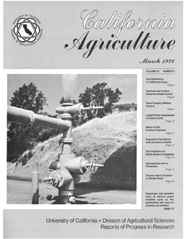


University of California
California Agriculture
|
|||
|
|||

Cover:
Exploration and establishrnent of electric power facilities such as this geothermal well may accelerate soil erosion.
March 1976
Volume 30, Number 3 |
|||
|
University of California, 1301 S. 46th St., Bldg. 478 Richmond, CA
|